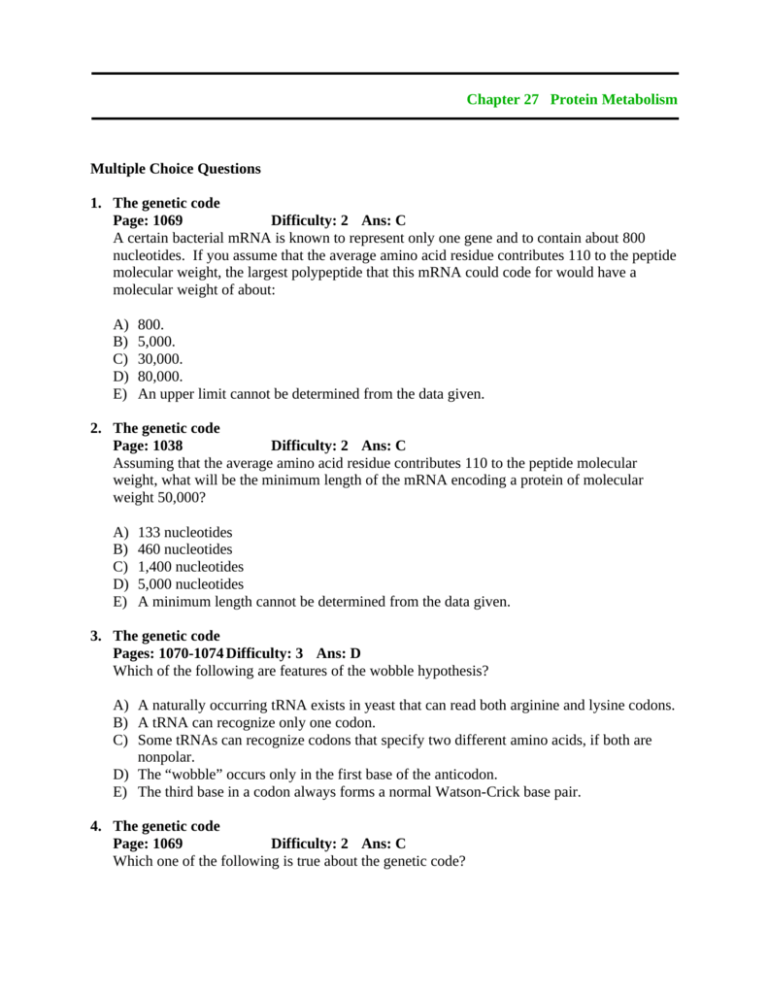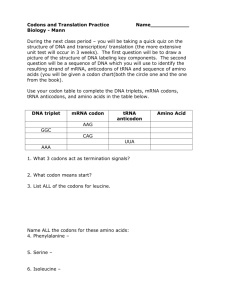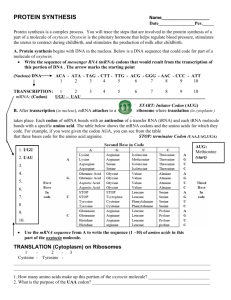Chapter 27 Protein Metabolism
advertisement

Chapter 27 Protein Metabolism Multiple Choice Questions 1. The genetic code Page: 1069 Difficulty: 2 Ans: C A certain bacterial mRNA is known to represent only one gene and to contain about 800 nucleotides. If you assume that the average amino acid residue contributes 110 to the peptide molecular weight, the largest polypeptide that this mRNA could code for would have a molecular weight of about: A) B) C) D) E) 800. 5,000. 30,000. 80,000. An upper limit cannot be determined from the data given. 2. The genetic code Page: 1038 Difficulty: 2 Ans: C Assuming that the average amino acid residue contributes 110 to the peptide molecular weight, what will be the minimum length of the mRNA encoding a protein of molecular weight 50,000? A) B) C) D) E) 133 nucleotides 460 nucleotides 1,400 nucleotides 5,000 nucleotides A minimum length cannot be determined from the data given. 3. The genetic code Pages: 1070-1074 Difficulty: 3 Ans: D Which of the following are features of the wobble hypothesis? A) A naturally occurring tRNA exists in yeast that can read both arginine and lysine codons. B) A tRNA can recognize only one codon. C) Some tRNAs can recognize codons that specify two different amino acids, if both are nonpolar. D) The “wobble” occurs only in the first base of the anticodon. E) The third base in a codon always forms a normal Watson-Crick base pair. 4. The genetic code Page: 1069 Difficulty: 2 Ans: C Which one of the following is true about the genetic code? A) B) C) D) All codons recognized by a given tRNA encode different amino acids. It is absolutely identical in all living things. Several different codons may encode the same amino acid. The base in the middle position of the tRNA anticodon sometimes permits “wobble” base pairing with 2 or 3 different codons. E) The first position of the tRNA anticodon is always adenosine. Chapter 27 Protein Metabolism 5. Protein synthesis Pages: 1076-1077 Difficulty: 1 Ans: D Which one of the following statements about ribosomes is true? A) B) C) D) E) The large subunit contains rRNA molecules, the small subunit does not. The RNA in ribosomes plays a structural, not catalytic, role. There are about 25 of them in an E. coli cell. There are two major subunits, each with multiple proteins. They are relatively small, with molecular weights less than 10,000. 6. Protein synthesis Pages: 1079-1080 Difficulty: 2 Ans: A Which of the following statements about tRNA molecules is false? A) A, C, G, and U are the only bases present in the molecule. B) Although composed of a single strand of RNA, each molecule contains several short, double-helical regions. C) Any given tRNA will accept only one specific amino acid. D) The amino acid attachment is always to an A nucleotide at the 3' end of the molecule. E) There is at least one tRNA for each of the 20 amino acids. 7. Protein synthesis Page: 1081 Difficulty: 2 Ans: A Aminoacyl-tRNA synthetases (amino acid activating enzymes): A) B) C) D) E) “recognize” specific tRNA molecules and specific amino acids. in conjunction with another enzyme attach the amino acid to the tRNA. interact directly with free ribosomes. occur in multiple forms for each amino acid. require GTP to activate the amino acid. 8. Protein synthesis Page: 1081-1083 Difficulty: 2 Ans: B In E. coli, aminoacyl-tRNA synthetases: A) B) C) D) activate amino acids in 12 steps. are amino acid–specific; there is at least one enzyme specific for each amino acid. have no proofreading activities. require a tRNA, an amino acid, and GTP as substrates. 9. Protein synthesis Pages: 1081-1084 Difficulty: 2 Ans: D Which of the following statements about aminoacyl-tRNA synthetases is false? A) Some of the enzymes have an editing/proofreading capability. 5 Chapter 27 Protein Metabolism B) C) D) E) The enzyme attaches an amino acid to the 3' end of a tRNA. The enzyme splits ATP to AMP + PPi. The enzyme will use any tRNA species, but is highly specific for a given amino acid. There is a different synthetase for every amino acid. 10. Protein synthesis Pages: 1081-1082 Difficulty: 2 Ans: D The enzyme that attaches an amino acid to a tRNA (aminoacyl-tRNA synthetase): 11. Protein synthesis Page: 1088 Difficulty: 1 Ans: B Which of the following is(are) true for protein synthesis in eukaryotes? A) B) C) D) E) All proteins are initially synthesized with methionine at their C-terminus. All proteins are initially synthesized with methionine at their N-terminus. All proteins are initially synthesized with tryptophan at their C-terminus. All proteins are initially synthesized with a multiple of 3 amino acids in their sequence. None of the above. 12. Protein synthesis Pages: 1088-1089 Difficulty: 2 Ans: A Formation of the ribosomal initiation complex for bacterial protein synthesis does not require: A) B) C) D) E) EF-Tu. formylmethionyl tRNAfMet. GTP. initiation factor 2 (IF-2). mRNA. 13. Protein synthesis Page: 1091 Difficulty: 2 Ans: D In bacteria the elongation stage of protein synthesis does not involve: A) B) C) D) E) aminoacyl-tRNAs. EF-Tu. GTP. IF-2. peptidyl transferase. 14. Protein synthesis Page: 1091 Difficulty: 2 Ans: E Which one of the following statements about the elongation phase of protein synthesis is true? A) At least five high-energy phosphoryl groups are expended for each peptide bond formed. Chapter 27 Protein Metabolism 6 B) During elongation, incoming aminoacylated tRNAs are first bound in the P site. C) Elongation factor EF-Tu facilitates translocation. D) Peptidyl transferase catalyzes the attack of the carboxyl group of the incoming amino acid on an ester linkage in the nascent polypeptide. E) Peptidyl transferase is a ribozyme. 15. Protein synthesis Pages: 1092-1093 Difficulty: 2 Ans: C Which of the following statements about bacterial mRNA is true? A) A ribosome usually initiates translation near the end of the mRNA that is synthesized last. B) An mRNA is never degraded but is passed on to the daughter cells at cell division. C) During polypeptide synthesis, ribosomes move along the mRNA in the direction 5' → 3'. D) The codon signaling peptide termination is located in the mRNA near its 5' end. 16. Protein synthesis Pages: 1092-1093 Bacterial ribosomes: A) B) C) D) Difficulty: 2 Ans: B bind tightly to specific regions of DNA, forming polysomes. contain at least one catalytic RNA molecule (ribozyme). have specific, different binding sites for each of the 20 tRNAs. require puromycin for normal function. 17. Protein synthesis Page: 1096 Difficulty: 1 Ans: B The large structure consisting of a mRNA molecule being translated by multiple copies of the macromolecular complexes that carry out protein synthesis is called a: A) B) C) D) E) lysosome. polysome. proteosome. ribosome. synthosome. 18. Protein synthesis Page: 1093 Difficulty: 3 Ans: C It is possible to convert the Cys that is a part of Cys-tRNACys to Ala by a catalytic reduction. If the resulting Ala-tRNACys were added to a mixture of (1) ribosomes, (2) all the other tRNAs and amino acids, (3) all of the cofactors and enzymes needed to make protein in vitro, and (4) mRNA for hemoglobin, where in the newly synthesized hemoglobin would the Ala from Ala-tRNACys be incorporated? A) Nowhere; this is the equivalent of a nonsense mutation B) Wherever Ala normally occurs Chapter 27 Protein Metabolism C) Wherever Cys normally occurs D) Wherever either Ala or Cys normally occurs E) Wherever the dipeptide Ala-Cys normally occurs 19. Protein synthesis Page: 1095 Difficulty: 3 Ans: D Approximately how many NTPs must be converted to NDPs to incorporate one amino acid into a protein? A) B) C) D) E) 0 1 2 4 8 Short Answer Questions 20. The genetic code Pages: 1066-1068 Difficulty: 3 Describe, succinctly, two ways in which synthetic polynucleotides were used in solving the genetic code (you need not describe how the synthetic polynucleotides were made). Ans: (1) When synthetic polymers of only one nucleotide were used as mRNA in vitro, only one of the 20 amino acids was converted into protein. For example, poly(U) (containing only the codon UUU) directed the synthesis of polyphenylalanine, showing that UUU encodes Phe. (2) Trinucleotides of known sequence were used to stimulate aminoacyl-tRNA binding to ribosomes. Because only that aminoacyl-tRNA whose anticodon matched the trinucleotide “mRNA” was bound, the coding specificity of each sequence of three bases could be determined by determining which of the 20 aminoacyl-tRNAs bound. (3) Random polymers of RNA containing known ratios of nucleotides (e.g., 70% A and 30% T) generate only certain codons in predictable ratios. The identities and ratios of the amino acids specified by such polymers provided important clues that helped solve the genetic code. (4) Additional assignments were made possible using synthetic oligonucleotides containing repeats of specific two, three, or four base pair sequences. 21. The genetic code Page: 1069 Difficulty: 3 You have isolated a fragment of viral DNA that totally encodes at least two proteins, 120 and 80 amino acids long. The DNA fragment is 400 base pairs long. (a) Why might you consider this unusual? (b) You sequence the two proteins and find no sequence homology. Propose a model to account for these findings. Ans: (a) Two distinct proteins of these sizes should require mRNAs of 360 and 240 base pairs because each amino acid residue requires 3 base pairs to code for it. (b) No homology means that the smaller protein cannot be derived from the larger by proteolysis; if it were, Chapter 27 Protein Metabolism 6 there would be 80 amino acid residues of identical sequence in the two proteins. One possible explanation is that the two genes coding for these proteins overlap and/or are read in different reading frames. 22. The genetic code Page: 1069 Difficulty: 2 The template strand of a segment of double-stranded DNA contains the sequence: (5')CTT TGA TAA GGA TAG CCC TTC (a) What is the base sequence of the mRNA that can be transcribed from this strand? (b) What amino acid sequence could be coded by the mRNA base sequence in (a), using only the first reading frame starting at the 5' end? (Refer to Fig. 27-7, p. 1069.) (c) Suppose the other (complementary) strand is used as a template for transcription. What is the amino acid sequence of the resulting peptide, again starting from the 5' end and using only the first reading frame? Ans: (a) (5')GAA GGG CUA UCC UUA UCA AAG(3’) (b) Glu-Gly-Leu-Ser-Leu-Ser-Lys (c) The codons translate to Leu-Stop-Stop. No peptide would be produced because of the stop codons. (See also Fig. 27-6, p. 1069.) 23. The genetic code Page: 1069 Difficulty: 3 Describe the possible outcomes that could occur because of a single base change in an mRNA Ans: The most likely result is a single amino acid change in the encoded protein, when a codon is altered to one of another amino acid. However, some nucleotide changes will be “silent” and not change the protein, if the altered codon still specifies the original amino acid. Conversion to a nonsense codon will result in a truncated polypeptide, while alteration of the normal stop codon to a “sense” codon will result in a lengthened protein. Alternation of the initiaton codon may result in the total failure to translate, and result in no protein product. Changes in mRNA sequence outside the protein-coding region may affect translational efficiency, splicing, or mRNA turnover rates. 24. The genetic code Page: 1069 Difficulty: 3 The following sequence of four amino acids occurred in the structure of a polypeptide found in a wild-type organism: Leu-Ser-Ile-Arg. Several mutants were isolated, each of which carried a single base pair change in the region of DNA that coded for this amino acid sequence. Their corresponding amino acid sequences are: Mutant 1 MET-Ser-Ile-Arg Chapter 27 Protein Metabolism 2 3 4 5 Leu-TRP-Ile-Arg Leu-Ser-ARG-Arg Leu-Ser-Ile-PRO Leu-Ser-Ile-TRP What was the nucleotide sequence of the region of mRNA that coded for the amino acid sequence in the wild-type organism? (Refer to Fig. 27-6, p. 1069.) Ans: (5')C or (5')U UG UCG AUA CGG Chapter 27 Protein Metabolism 6 25. The genetic code Pages: 1070-1074 Difficulty: 2 In protein synthesis, 61 codons specify the 20 amino acids. Base pairing between the codon and the tRNA anticodon assures that the correct amino acid will be inserted into the nascent polypeptide chain. Why then does the cell require only 32 different tRNAs to recognize 61 different codons? Ans: Certain tRNAs have the unusual nucleotide inosinate in the first anticodon position. Because inosinate can base pair with A, U, or C, a tRNA containing hypoxanthine can recognize three different codons. In each recognized codon, there is a standard anticodoncodon base pair with the first two bases of the codon; “wobble” in the third base pair allows one tRNA to read three different codons. Similarly, tRNAs with U or G in the first anticodon position also exhibit a wobble effect that permits pairing with two different codons. 26. Protein synthesis Pages: 1076-1079 Difficulty: 1 Indicate whether the following statements are true (T) or false (F). ___A ribosome is the complex within which protein synthesis occurs. ___Ribosomes contain many separate proteins. ___The three ribosomal RNAs in a bacterial ribosome are distributed in three separate, large ribosomal subunits. ___There are four binding sites for aminoacyl-tRNAs on a ribosome. Ans: T; T; F; F 27. Protein synthesis Pages: 1081-1083 Difficulty: 2 The process of charging tRNAs with their cognate amino acids involves multiple proofreading steps to increase the overall fidelity. Briefly describe these steps. Ans: There are two main stages of selection: 1) the synthetase strongly favors activation of the correct amino acid to become aminoacyl-AMP (incorrect amino acids are very poorly activated) and 2) when the correct uncharged tRNA is bound to the enzyme, only the correct aminoacyl-AMP is tolerated in the “proofreading” active site (incorrect aminoacyl-AMPs, though they may become bound, are rapidly hydrolyzed). In addition, for most synthetases, if their tRNA does manage to become acylated by the wrong amino acid, that product is also rapidly hydrolyzed. 28. Protein synthesis Page: 1088-1090 Difficulty: 3 A given mRNA sequence might be translated in any of three reading frames. Describe how prokaryotes determine the correct reading frame. Ans: In prokaryotes, the Shine-Dalgarno sequence in the mRNA base pairs with a complementary sequence in the 16S RNA of the ribosome; this positions the correct start Chapter 27 Protein Metabolism codon (AUG) on the 30S ribosomal subunit. Thus, the initiating AUG is distinguished by its proximity to the Shine-Dalgarno sequence. 29. Protein synthesis Pages: 1088-1095 Difficulty: 1 Match the factor or enzyme at the right with the stage(s) of protein synthesis at which it acts. If a factor or enzyme participates in two stages of protein synthesis, indicate both of them. ___ ___ ___ ___ Amino acid activation Initiation Elongation Termination (a) RF1 (b) EF-Tu (c) aminoacyl-tRNA (d) Shine-Dalgarno sequence Ans: c; d; b; a 30. Protein synthesis Pages: 1088-1095 Difficulty: 2 Indicate whether each of the following statements is true (T) or false (F). ___Assembly of a complete ribosome onto an mRNA requires ATP hydrolysis. ___Aminoacylation or “charging” of tRNA requires the formation of an aminoacyl-AMP intermediate. ___Aminoacyl-tRNA binding to the A site of the ribosome requires the accessory factor EF-G and GTP hydrolysis. ___Translocation of a growing polypeptide from the A to the P site on the ribosome requires EF-G and GTP hydrolysis. ___Termination of translation requires release factors, but no NTP hydrolysis. Ans: F; T; F; T; T 31. Protein synthesis Pages: 1088-1096 Difficulty: 2 Indicate whether each of the following statements is true (T) or false (F). ___ Bacterial mRNA is broken down within a few minutes of its formation in E. coli. ___ Bacterial mRNA consists only of the bases that code for amino acids. ___ Polysomes do not necessarily contain mRNA. ___ Bacterial mRNA normally occurs as a double-stranded structure, with one strand containing codons, the other containing anticodons. ___ Bacterial mRNA can be translated while it is still being synthesized. Ans: T; F; F; F; T 32. Protein synthesis Pages: 1091-1094 Difficulty: 2 Polypeptide chain elongation in E. coli occurs by the cyclical repetition of three steps. What Chapter 27 Protein Metabolism are these steps and what cellular components are necessary for each of them to occur? Ans: The three steps are: (1) An aminoacyl-tRNA is brought to the A site by EF-Tu with bound GTP; (2) peptidyl transferase (a ribozyme) catalyzes peptide-bond formation; (3) the ribosome translocates three nucleotides down the mRNA, helped by EF-G (translocase). This shifts the peptidyl-tRNA to the A site and the deacylated tRNA to the E site. 33. Protein synthesis Pages: 1091-1092 Difficulty: 2 A new antibiotic was recently discovered that inhibits prokaryotic protein synthesis. In the presence of the antibiotic, protein synthesis can be initiated, but only dipeptides that remain bound to the ribosome are formed. What specific step of protein synthesis is likely to be blocked by this antibiotic? Ans: The antibiotic probably blocks translocation. 6









